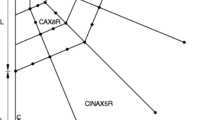Abstract
Based on the elastic theory assumptions and averaging theories, an infinite element boundary which is frequency independent is derived for saturated soil media. The infinite element development is based on mapping functions and viscous layers for damping propagating waves of both solid and water phases. The newly developed infinite element is able to simulate the boundaries of fully saturated soil medium considering both soil displacement and fluid pressures. The main point is that the fluid pressure gradient at infinity is taken to equal to zero thus enabling the realistic consideration of the fluid pressures in numerical simulations. In numerical modelling, the general finite element software ANSYS using its User Programmable Features is used. Related comparisons are done with references. In simulation of propagating waves, the numerical approach is verified considering different models. The verification models include wave propagation through a saturated soil column. The implementation of the newly developed infinite element is done by simulation of an earth fill dam boundaries while the dam body is simulated as a three-phase medium. The obtained results from simulations show promising results and are thoroughly discussed.












Similar content being viewed by others
References
Albers B, Wilmanski K (2006) Influence of coupling through porosity changes on the propagation of acoustic waves in linear poroelastic materials. Archive Mech 58(4–5):313–325
ANSYS (2006) Fem software
Askar H (1993) Stresses in ground-freezing problems with infinite boundaries. J Eng Mech 119(1):58–73
Astley RJ (2000) Infinite elements for wave problems: a review of current formulations and an assessment of accuracy. Int J Numer Methods Eng 49(7):951–976
Bathe KJ (1982) Finite Element Procedures in Engineering Analysis. Prentice-Hall, Englewood Cliffs
Bettess P, Elements I (1992) New castle. Penshaw Press, England
Edip K (2013) Development of three phase model with finite and infinite elements for dynamic analysis of soil media. In: Ss. Cyril and Methodius. Institute of Earthquake Engineering and Engineering Seismology.
Edip K et al (2018) Coupled approach in simulation of earth dam. In: 16th European conference on earthquake engineering 2018. The European Association for Earhtquake Engineering, Thessaloniki, Greece
Häggblad B, Nordgren G (1987) Modelling nonlinear soil-structure interaction using interface elements, elastic-plastic soil elements and absorbing infinite elements. Comput Struct 26(1–2):307–324
Heider Y, Markert B, Ehlers W (2010) Dynamic wave propagation in porous media semi-infinite domains. PAMM 10(1):499–500
Kausel E (2010) Early history of soil–structure interaction. Soil Dyn Earthq Eng 30(9):822–832
Liao Z-P (1996) Extrapolation non-reflecting boundary conditions. Wave Motion 24(2):117–138
Lysmer J, Kuhlmeyer RL (1969) Finite dynamic model for infinite media. J Eng Mech Div 95:859–877
Manolis G, Ahmad S, Banerjee P (1986) Boundary element method implementation for three-dimensional transient elastodynamics. In: Developments in boundary element methods- 4(A 86-38966 18-31). Elsevier Applied Science Publishers, London and New York, pp 29–65.
Medina F, Penzien J (1982) Infinite elements for elastodynamics. Earthq Eng Struct Dyn 10(5):699–709
Mesgouez A, Lefeuve-Mesgouez G (2009) Study of transient poroviscoelastic soil motions by semi-analytical and numerical approaches. Soil Dyn Earthq Eng 29(2):245–248
Oettl G (2003) A three-phase FE-model for dewatering of soils by means of compressed air. Universitaet Innsbruck
Pastor M et al (1999) Stabilized finite elements with equal order of interpolation for soil dynamics problems. Arch Comput Methods Engineering 6(1):3–33
Schrefler B, Simoni L (1987) Non-isothermal consolidation of unbounded porous media using mapped infinite elements. Commun Appl Numer Methods 3(5):445–452
Simoni L, Schrefler BA (1987) Mapped infinite elements in soil consolidation. Int J Numer Methods Eng 24(3):513–527
Zhao C, Valliappan S (1993) A dynamic infinite element for three-dimensional infinite-domain wave problems. Int J Numer Meth Eng 36(15):2567–2580
Zienkiewicz OC, Emson C, Bettess P (1983) A novel boundary infinite element. Int J Numer Methods Eng 19(3):393–404
Author information
Authors and Affiliations
Corresponding author
Additional information
Publisher's Note
Springer Nature remains neutral with regard to jurisdictional claims in published maps and institutional affiliations.
Appendix
Appendix
The mass matrices are given as follows:
The coupling matrix follows as:
The compressibility matrix is given as:
The permeability matrix can be written as:
The domain forces follow as:
Rights and permissions
About this article
Cite this article
Edip, K., Sheshov, V., Wu, W. et al. Numerical modelling of saturated boundless media with infinite elements. Acta Geotech. 16, 2683–2692 (2021). https://doi.org/10.1007/s11440-020-01139-9
Received:
Accepted:
Published:
Issue Date:
DOI: https://doi.org/10.1007/s11440-020-01139-9




